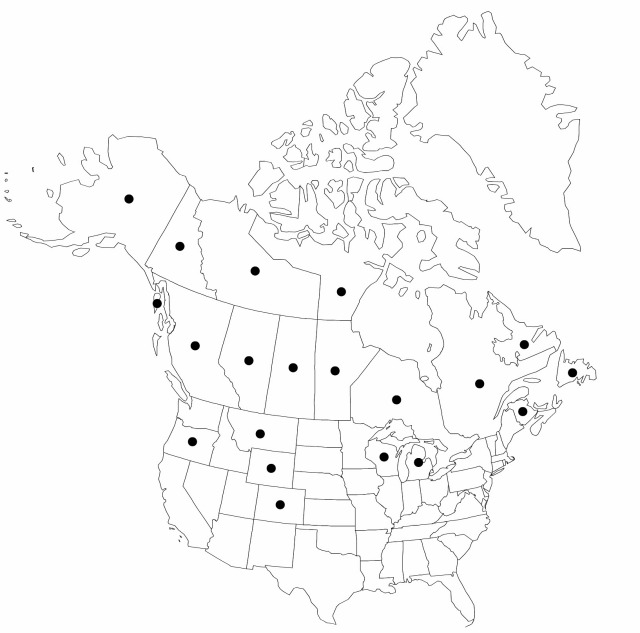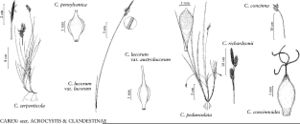Carex concinna
in J. Franklin et al., Narr. Journey Polar Sea, 751. 1823.
Plants densely cespitose, short-rhizomatous. Culms 5.5–20 cm. Leaves: basal sheaths reddish-brown, blades mostly basal, pale green, shorter than culms, thin, 1–3.1 mm wide. Inflorescences: peduncles of proximal spikes short; peduncles of terminal staminate spikes 1–3.1 mm; proximal bracts short-sheathing; pistillate spikes 2–3, emerging from cauline nodes, aggregated, ascending, ovoid to ellipsoid; terminal staminate spikes 5–6.8 × 1.1–1.5 mm. Scales: pistillate scales reddish-brown, ovate, apex obtuse, minutely ciliate. Anthers 1.3–1.4 mm; staminate scales dark reddish-brown, ovate, margins white, apex obtuse to rounded, scarious. Perigynia ellipsoid, 2.3–3.3 × 1.1–1.4 mm, base cuneate, pubescent with coarse, wrinkled white hairs; beak straight, 0.3–0.4 mm. Stigmas 3, thin, flexuous, strongly papillose. Achenes ellipsoid, 1.7–2.1 × 1–1.3 mm. 2n = 54.
Phenology: Fruiting spring–summer (late May–late Jul).
Habitat: Moist to dry meadows, riverbanks, thickets, flood plains, and open spruce, pine, cedar, birch, aspen, and willow woodlands, usually on calcareous substrates
Elevation: 0–3000 m
Distribution

Alta., B.C., Man., N.B., Nfld. and Labr., N.W.T., Nunavut, Ont., Que., Sask., Yukon, Alaska, Colo., Mich., Mont., Oreg., Wis., Wyo.
Discussion
Carex concinna is common in northern Canada and Alaska, particularly in the western mountains in the montane zone. It is often abundant, along with C. richardsonii, on open gravelly or sandy banks of spring flood channels. Superficially, C. concinna looks quite similar to C. deflexa Hornemann and C. rossii Boott of sect. Acrocystis. It differs from them in its strongly sheathing, short-bladed bracts, perigynium indument of coarse, wrinkled hairs, and minutely ciliate pistillate scale apices.
Selected References
None.
Lower Taxa
"shortened" is not a number."thin" is not a number.
